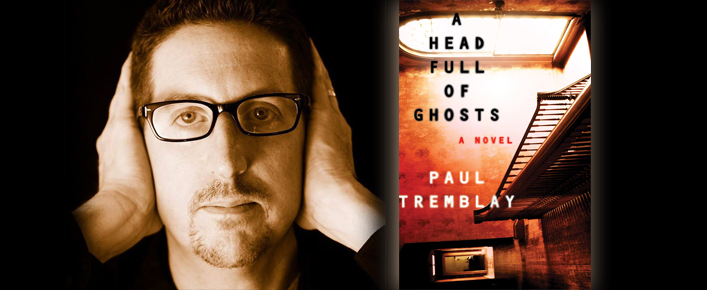
By Heidi Simmons
—–
A Head Full of Ghosts
by Paul Tremblay
Fiction
—–
The idea of “possession” is terrifying. Whether it is a result of a psychological breakdown, schizophrenia or a full-blown demon, it is a horrific problem to overcome — if indeed it can be resolved. When a child is involved, it is even more disturbing. In Paul Tremblay’s A Head Full of Ghosts, (William Morrow, 288 pages) one child must take a fresh look at what haunts her.
Marjorie and Merry are sisters. They live like most families — good neighborhood, nice house, decent schools, no drama. But the girls father has been out of work for nearly a year and the stress on their mother is starting to take a toll on the whole family. They are a mortgage payment away from to losing their home.
Marjorie is 14 years old and Merry is eight. Merry loves the attention of her older sister. And most of the time, Marjorie is kind and friendly to Merry. The two girls are creative and silly. But when Marjorie starts to act strangely everything in the house shifts.
Marjorie no longer showers or washes her hair and she talks back to her folks. She swears and behaves obscenely. This confuses young Merry. Things move about the house and there are weird incidents that seemingly cannot be explained.
Not knowing how to control her teenage daughter, the mother wants Marjorie to go get medical help. But the cost for Marjorie’s mental health treatment is expensive.
The father turns to the church. Since they are a non-religious family, this baffles the mother and girls. Now their dad prays for help, and instead of taking Marjorie to her doctor’s appointment, he takes her to see a priest.
It’s clear to the priest that Marjorie is possessed and suggests an exorcism. The priest knows a producer who will pay the family to film the ordeal. The producer sells the project/idea as a reality television series. The money helps the family get back on their financial feet.
The film crew comes into the home and takes over. They shoot video for weeks. A date is set for the exorcism. Marjorie is strapped to the bed and the rituals are performed. Little Merry is asked to participate because the demon is most active when Merry is present.
As things get even weirder, Merry runs out of the room and Marjorie follows. For a bit, Marjorie floats over the upstairs rail and levitates. All of it caught on reality TV cameras.
There are moments when author Tremblay nails the creepiness and terrifying encounters between the sisters that suggest this is going to get bad for both girls and their parents.
What makes the story even more eerie is that the narrator, Merry, is only eight. Although, she is telling the story ten years after the fact, the little girl who remembers is completely unreliable and does her best to recall all that happened.
Tremblay tells the story through Merry’s Blog. Her Blog is flippant and unclear. Tremblay communicates well — his writing is fine, but in his attempt to tell the story in perhaps a fresh new way, he loses the magic and power of the horror.
This story works best when he tells the events straight forward from Merry’s young point of view. The first three chapters are confusing and odd. But once Merry takes the helm and describes what happened from her perspective, the story comes together and is suddenly compelling.
I love the use of an unreliable narrator in literature. This is my favorite story telling method because it forces the reader to engage and look more closely at what is happening in the text but in the wider world. It takes a very competent, self-aware writer to successfully make this work.
A child’s perspective is always going to be off center. A young person does not have the experience or knowledge to know what is really happening and whether it’s right or wrong, good or bad, common or uncommon. This makes a story far more engaging when well-written.
As the story unfolds, it becomes obviously clear there is something else going on. But the reader must wait, and that wait does not lead to the expected surprising payoff. That would normally be a good thing, but in this case, the ending is a strange and sad finale that seems out of the blue. Yet, it is horrifying and disturbing. I only wish it was executed better.
Tremblay’s attempt to make the story more suspenseful through the use of a Blog and interviews, actually distracts from the terror. It certainly doesn’t help. I do like that the author leaves the reader wondering whose head is really filled with ghosts. Little Merry is very scary.












































